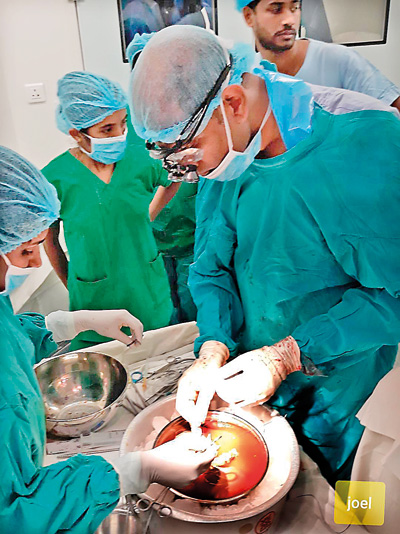News
Rare liver transplant at A’pura Teaching Hospital
View(s):The first successful cadaveric liver transplant – that means from a brain dead donor – was done by a team led by Dr Joel Arudchelvam, Consultant Vascular and Transplant surgeon at the Teaching Hospital in Anura-dhapura.

Dr. Joel (second from left) and his team
Dr Arudchelvam said the recipient, a 43-year-old male who had cirrhosis, was doing well and had gone home without complications. The liver was taken from a 22-year-old male donor diagnosed with brain death following a road traffic accident.
The organ retrieval and the transplant – a surgical process which lasted for about eight hours – had been done by the same team of doctors. The donor surgery was done first and the liver after being inspected for fat, abnormal blood vessels, injuries and tumours was transplanted into the cirrhotic patient.
In the post–operative period the patient was monitored in the Intensive Care Unit (ICU). The doctors were especially checking for problems in the bile duct and hepatic arteries, for bile duct leaks and arterial thrombosis. While a leak could be corrected by inserting stents, an arterial thrombosis in a patient would make the surgery futile, and there would be a need for a fresh liver transplant, the consultant said.
Thereafter, the patient needed to be on anti-rejection medications and regular medical check ups for life as there were possibilities of the body rejecting the new liver.

The procedure in progress
The general cause of liver disease in patients is cirrhosis. The excessive consumption of alcohol, is the most common cause for it. Fat deposition in the liver or ‘fatty liver’ and infections like hepatitis B and hepatitis C are also causes of the illness.
Problems in biliary tree, that is the drainage duct of the liver, could result in biliary cirrhosis. In females autoimmune hepatitis was common and this could lead to cirrhosis. In children liver dysfunction and failure of the biliary atresia wete common causes. In some patients the cause for cirrhosis was not obvious and it was termed cryptogenic cirrhosis, the consultant said.
The patient who underwent the liver transplant at the Teaching Hospital in Anuradhapura had cryptogenic cirrhosis.
Dr. Arudchelvam said that patients under 60 years of age who did not have any debilitating illnesses including heart and lung diseases, were considered fit for the transplant. Also they should be free of serious infections like tuberculosis.
The liver donors are of two types: live donors, who donate part of their liver and cadaveric or brain dead donors.
In addition to the current liver transplant, various other transplants have been done for the first time in Sri Lanka, at the Anurdhapura Teaching Hospital by Dr. Joel Arudchelvam and his team.
These include Simultaneous Pancreas Kidney transplantation (SPK) and enbloc kidney transplantation, done in 2016. A lower limb transplantation, the fifth in the world, was done in 2017. Dr. Joel Arudchelvam’s team includes Dr. Amanthana Marasinghe, Dr. Lewan Kariyawasam and Dr. Nadun Mohotti.

